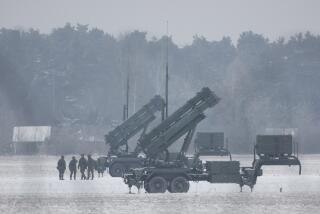U.S. Sees Massaging of Numbers in Warsaw Pact Data
- Share via
WASHINGTON — The Bush Administration, joined by top officials of the North Atlantic Treaty Organization, said Monday that a Warsaw Pact report claiming East-West equality in non-nuclear arms is based on statistical sleight-of-hand intended to mask an overwhelming superiority by the Soviet-led bloc in tanks, artillery and other “offensive” weaponry.
A State Department official said the Warsaw Pact analysis is misleading because it inflates NATO’s military strength by including U.S. ground and air forces assigned to missions outside of Europe and by adding in the naval forces of the two blocs, which would play only a peripheral role if war should break out in Central Europe.
“We do not agree that NATO’s and the Warsaw Pact’s conventional forces in Europe are roughly equal,” the official said.
Nevertheless, the official welcomed the Warsaw Pact report, which was the most comprehensive listing of military power ever made public by the Soviet Union and its allies. Previously, they had insisted on keeping such figures secret.
“We hope that this publication is a symbol of greater openness to come,” the U.S. official said.
The report was issued in advance of the scheduled March 9 start of a new round of negotiations on non-nuclear armaments in Europe. The 16 NATO and seven Warsaw Pact nations agreed last month to begin the negotiations--known as CAFE talks, for Conventional Armed Forces in Europe.
As a necessary preliminary, each side agreed to draw up a list of its forces “from the Atlantic to the Urals.” NATO published figures on its forces last November.
But the disagreement over the size and capability of forces points to tough bargaining ahead. The last attempt at East-West conventional arms limitation broke down without any results after 15 years of frustration, much of it the result of definitional and semantic disputes.
NATO officials promised to study the latest Warsaw Pact report carefully. Although openly skeptical, they did not reject the Eastern report out of hand.
Gen. John R. Galvin, NATO’s supreme commander, said in a statement issued at his headquarters in Mons, Belgium, that the alliance is “scrutinizing the Warsaw Pact numbers, and there are some confusing points.”
But he added: “I definitely do not agree that a rough parity of conventional forces already exists in Europe. We have challenged the Warsaw Pact to provide this data for many years. We can now approach the new . . . negotiations with a better understanding of each side’s perspective. At any rate, the real challenge is now for us all to go to Vienna, roll up our sleeves and begin the task of moving toward conventional parity.”
In London, a British Foreign Office spokesman said of the Warsaw Pact troop announcement: “We are certainly pleased (that) the Warsaw Pact has made such a statement. This is something we have been asking for a long time. But it leaves many questions unanswered. We still need an explanation of how they define their terms.”
The State Department official said: “We note that the Warsaw Pact publication includes information on (U.S.) forces outside of Europe. Those forces are not necessarily dedicated to the European theater alone and may have missions elsewhere in the world. Attempts to include them in alliance-to-alliance comparisons of forces in Europe is misleading.”
However, the official said, the Warsaw Pact’s figures show an Eastern superiority in tanks, artillery and armored personnel carriers--the weapons that would be needed to spearhead an attack in central Europe--although the disparity is a little less than reported by NATO.
In Bonn, coincidentally, the West German government announced Monday that Soviet President Mikhail S. Gorbachev will visit West Germany beginning June 12.
NATO analysts in the West German capital speculated that Gorbachev will use the Bonn visit as an opportunity to announce further arms cuts in Europe.
At the upcoming conventional arms talks, NATO negotiators hope to get Moscow to accept the principle of asymmetry in reducing their heavier armaments roughly to the size of NATO’s--before any additional weapons cuts are made.
Kempster reported from Washington, Tuohy from Bonn.
More to Read
Sign up for Essential California
The most important California stories and recommendations in your inbox every morning.
You may occasionally receive promotional content from the Los Angeles Times.













